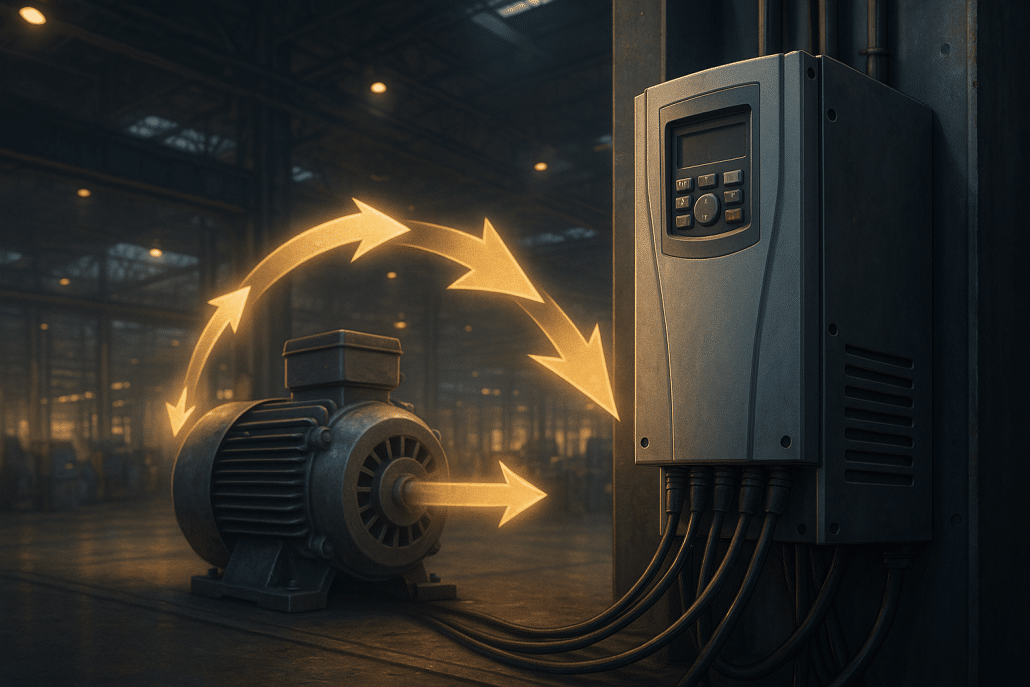Variable Speed Drive — Boost Efficiency & Cut Energy Costs
Estimated reading time: 4 minutes
Introduction
Electric motors power nearly every industrial and commercial process, yet they rarely need to run at full throttle. A variable speed drive (VSD) — also called a variable frequency drive (VFD) or adjustable speed drive — lets you dial in precisely the speed and torque a load requires instead of wasting energy with valves, dampers, or mechanical gear shifts. Consequently, facilities routinely report 20‑60 % energy savings and dramatic improvements in process stability after installing modern AC drives. Because motors consume about 70 % of industrial electricity, optimizing them with a VSD is one of the fastest ways to shrink utility bills and carbon footprints while extending equipment life.
Why Motors Waste Energy Without a Variable Speed Drive
Historically, engineers sized motors for the worst‑case scenario and ran them at rated speed around the clock. However, most pumps, fans, and conveyors operate well below peak demand most of the time. When flow or airflow did not match the set‑point, operators relied on throttling devices that forced the motor to fight against an artificial restriction. Although this technique looked simple, it translated the motor’s full power into heat, vibration, and noise instead of useful work. In HVAC plants, for example, a 20 % reduction in fan speed can cut power roughly in half, yet a fixed‑speed motor plus a damper still burns almost 100 % of the energy. Hence, every excess RPM costs money.
Beyond wasted kilowatt‑hours, across‑the‑line starts hammer belts, gearboxes, and couplings with inrush currents six to eight times the motor’s full‑load amps. Bearings fail sooner, pipelines endure water hammer, and production quality drifts whenever operators tweak mechanical bypasses. Ultimately, the facility pays twice — first on the utility bill, then on maintenance.

How a Variable Speed Drive Solves the Problem
A modern AC drive rectifies incoming AC to DC, smooths it in a DC bus, and inverts it back to a synthesized PWM waveform at the frequency you specify. Because torque in an induction or permanent‑magnet motor is proportional to voltage‑per‑hertz, the VSD keeps magnetic flux constant while the controller varies speed from zero to well above base frequency. As a result, pumps and fans follow the cube law: cut speed 50 %, drop power about 87 %. The ABB ACS880 catalog shows efficiencies above 97 %, so almost every watt withdrawn from the mains turns into useful shaft work.
Because the inverter starts the motor softly, inrush disappears. Torque ramps in smoothly, protecting mechanical elements and stopping pressure spikes. Furthermore, drives deliver full rated torque — even 200 % at low speed on some Hitachi WJ‑200 models — without an encoder. When loads overrun, regenerative or braking choppers safely absorb or return energy. Therefore, the production line gains tighter control, less scrap, and quieter operation.
Best Variable Speed Drive Products for 2025
- ABB ACS580 General‑Purpose Drive – ULH option slashes THDi below 3 % and meets IEEE‑519 without external filters.
- Yaskawa GA800 – Documented 28‑year MTBF; Bluetooth commissioning app speeds start‑up.
- Eaton DG1 – Built‑in Active Energy Control trims extra current at partial load, adding about 10 % savings.
- Lenze i500 – Slim, modular, and available with IP65 motor‑mount housings for decentralized conveyors.
You can purchase these families directly from Precision Electric. Browse our stocked categories for ABB drives, Yaskawa drives, and Eaton drives to compare horsepower, voltage, and enclosure ratings.

Key Implementation Tips
First, size the controller for the heaviest anticipated torque and select the correct duty rating. Second, add a 3–5 % line reactor or DC choke to reduce harmonics and protect rectifiers. Third, specify shielded inverter cable and ground both ends to divert high‑frequency currents away from bearings; if runs exceed 150 ft, include a dV/dt filter. Moreover, program PID loops inside the drive to maintain flow or pressure automatically and log energy data for continuous improvement. Finally, schedule annual fan inspections and capacitor health checks — simple tasks that keep downtime near zero.
Need more detail? Our cornerstone tutorial VFD Maintenance Checklist walks through every preventive step. Additionally, the Schneider Electric energy‑savings study confirms 30‑50 % cuts on centrifugal loads, while a Fraunhofer Institute report estimates 120 TWh annual potential across Europe. Therefore, proven data backs every recommendation.
Conclusion
In short, a correctly applied variable speed drive converts electricity into useful work with minimal waste, safeguards machinery, and empowers operators with digital insight. Because installation costs continue to fall while energy prices rise, the payback window narrows every year. Take the next step by contacting Precision Electric for application support and by reading the resources below.









Trackbacks & Pingbacks
[…] drives, a best practice noted in guides from Com. This advanced insight ensures the Lenze variable speed drive is optimized for performance and […]
[…] The quest for a smarter solution has led to widespread adoption of technologies like the Invertek variable speed drive, which directly addresses these inefficiencies by precisely controlling motor speed. According to […]
[…] control over AC motor speed and torque for a vast range of applications. In essence, a Hitachi variable speed drive optimizes motor performance and reduces mechanical stress on equipment. It also generates […]
[…] applications, from simple fans and pumps to complex material handling systems. At its core, an ABB variable speed drive functions by converting fixed-frequency incoming power into a variable-frequency, variable-voltage […]
[…] its advanced control features, the variable speed drive ACS880 is built for durability and flexibility. The drives are available in a wide power range and […]
[…] control in countless applications. These compact yet powerful devices, often referred to as the ABB variable speed drive, are engineered for simplicity, efficiency, and dependability. In fact, their reputation is built […]
[…] their efficiency and robust design, a point detailed by orientalmotor.com. Consequently, matching a variable speed drive to these motors involves more than just aligning horsepower ratings; it demands a holistic review […]
[…] variable frequency drive (VFD) is a cornerstone of modern motor control. A VFD, also known as a variable speed drive or Siemens AC drive, precisely regulates an electric motor’s speed and torque by varying the […]
Comments are closed.